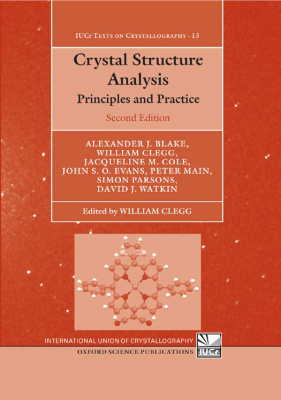Oxford University Press, 2009, Eds. Alexander J. Blake, William
Clegg, Jacqueline M. Cole, John S.O. Evans, Peter Main, Simon
Parsons, and David J. Watkin, 406 p.
Introduction to diffraction
Introduction
X-ray scattering from electrons
X-ray scattering from atoms
X-ray scattering from a unit cell
The effects of the crystal lattice
X-ray scattering from the crystal
The structure-factor equation
The electron-density equation
A mathematical relationship
Bragg’s law
Resolution
The phase problem
Introduction to symmetry and diffraction
The relationship between a crystal structureand its diffraction patte
Translation symmetry in crystalline solids
Symmetry of individual molecules, with relevance to crystalline solids
Symmetry in the solid state
Diffraction and symmetry
Further points
Exercises
Crystal growth and evaluation
Introduction
Protect your crystals
Crystal growth
Survey of methods
Evaluation
Crystal mounting
Space-group determination
Introduction
Prior knowledge and information other than from diffraction
Metric symmetry and Laue symmetry
Unit cell contents
Systematic absences
The statistical distribution of intensities
Other points
A brief conducted tour of some entries in Inteational Tables for Crystallography, Volume A
Exercises
Background theory for data collection
Introduction
A step-wise theoretical jouey through an experiment
The geometry of X-ray diffraction
Determining the unit cell: the indexing process
Relating diffractometer angles to unit cell parameters: determination of the orientation matrix
Data-collection procedures and strategies
Criteria for selecting which data to collect
How best to measure data: the need for re?ection scans
Extracting data intensities: data integration and reduction
Exercises
Practical aspects of data collection
Introduction
Collecting data with area-detector diffractometers
Experimental conditions
Types of area detector
Some characteristics of CCD area-detector systems
Crystal screening
Data collection
Exercises
Practical aspects of data processing
Data reduction and correction
Integration input and output
Corrections
Output
A typical experiment?
Examples of more problematic cases
Twinning and area-detector data
Some other special cases (in brief)
Exercises
Fourier syntheses
Introduction
Forward and reverse Fourier transforms
Some mathematical and computing considerations
Uses of different kinds of Fourier syntheses
Weights in Fourier syntheses
Illustration in one dimension
Exercises
Patterson syntheses for structure determination
Introduction
What the Patterson synthesis means
Finding heavy atoms from a Patterson map
Patterson syntheses giving more than one possible solution, and other problems
Patterson search methods
Exercises
Direct methods of crystal-structure determination
Amplitudes and phases
The physical basis of direct methods
Constraints on the electron density
и т. д.
Introduction to diffraction
Introduction
X-ray scattering from electrons
X-ray scattering from atoms
X-ray scattering from a unit cell
The effects of the crystal lattice
X-ray scattering from the crystal
The structure-factor equation
The electron-density equation
A mathematical relationship
Bragg’s law
Resolution
The phase problem
Introduction to symmetry and diffraction
The relationship between a crystal structureand its diffraction patte
Translation symmetry in crystalline solids
Symmetry of individual molecules, with relevance to crystalline solids
Symmetry in the solid state
Diffraction and symmetry
Further points
Exercises
Crystal growth and evaluation
Introduction
Protect your crystals
Crystal growth
Survey of methods
Evaluation
Crystal mounting
Space-group determination
Introduction
Prior knowledge and information other than from diffraction
Metric symmetry and Laue symmetry
Unit cell contents
Systematic absences
The statistical distribution of intensities
Other points
A brief conducted tour of some entries in Inteational Tables for Crystallography, Volume A
Exercises
Background theory for data collection
Introduction
A step-wise theoretical jouey through an experiment
The geometry of X-ray diffraction
Determining the unit cell: the indexing process
Relating diffractometer angles to unit cell parameters: determination of the orientation matrix
Data-collection procedures and strategies
Criteria for selecting which data to collect
How best to measure data: the need for re?ection scans
Extracting data intensities: data integration and reduction
Exercises
Practical aspects of data collection
Introduction
Collecting data with area-detector diffractometers
Experimental conditions
Types of area detector
Some characteristics of CCD area-detector systems
Crystal screening
Data collection
Exercises
Practical aspects of data processing
Data reduction and correction
Integration input and output
Corrections
Output
A typical experiment?
Examples of more problematic cases
Twinning and area-detector data
Some other special cases (in brief)
Exercises
Fourier syntheses
Introduction
Forward and reverse Fourier transforms
Some mathematical and computing considerations
Uses of different kinds of Fourier syntheses
Weights in Fourier syntheses
Illustration in one dimension
Exercises
Patterson syntheses for structure determination
Introduction
What the Patterson synthesis means
Finding heavy atoms from a Patterson map
Patterson syntheses giving more than one possible solution, and other problems
Patterson search methods
Exercises
Direct methods of crystal-structure determination
Amplitudes and phases
The physical basis of direct methods
Constraints on the electron density
и т. д.

